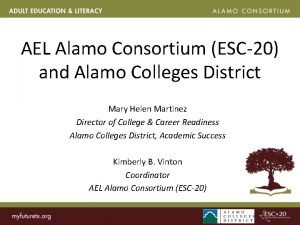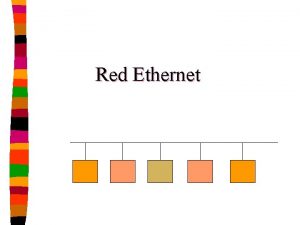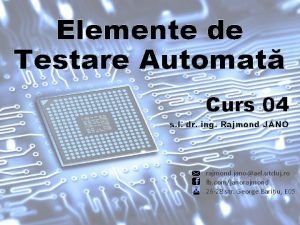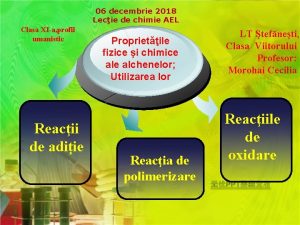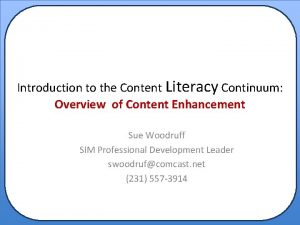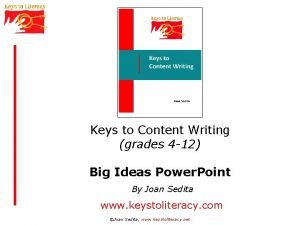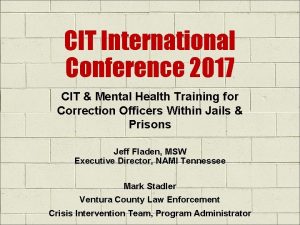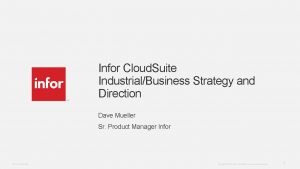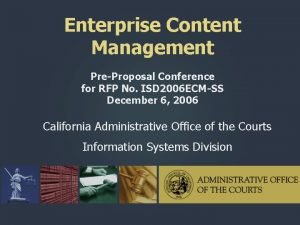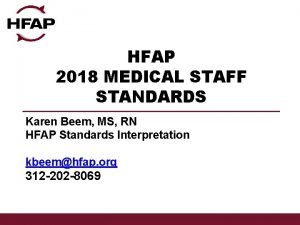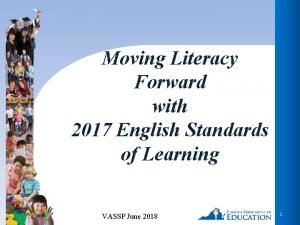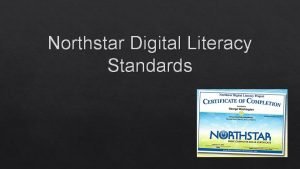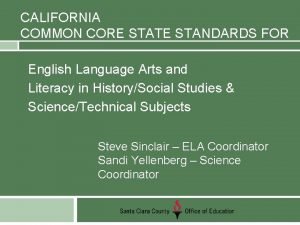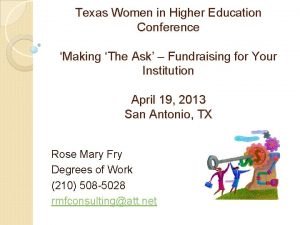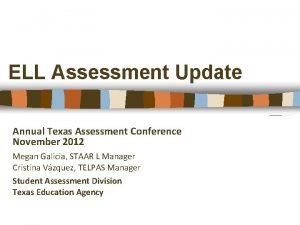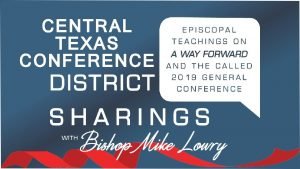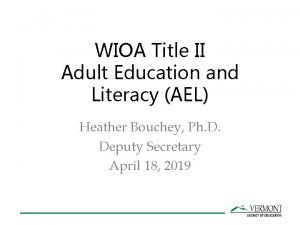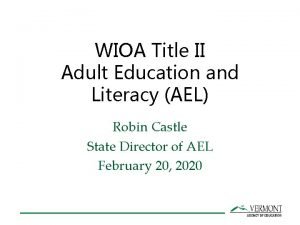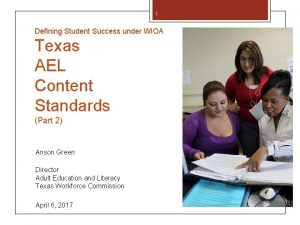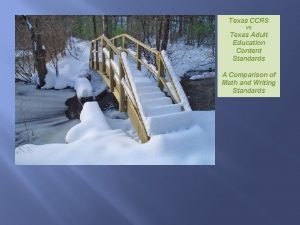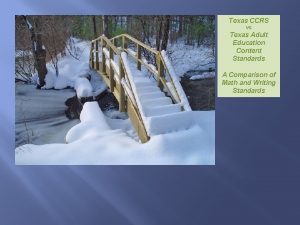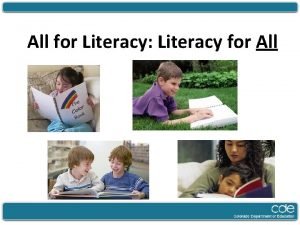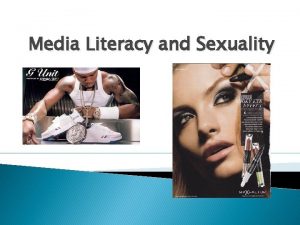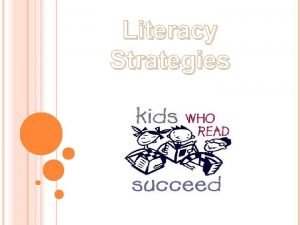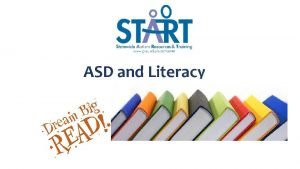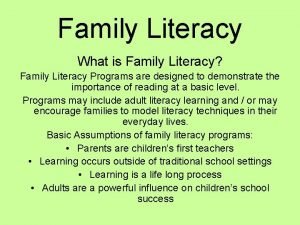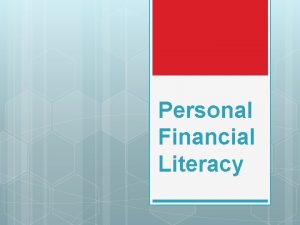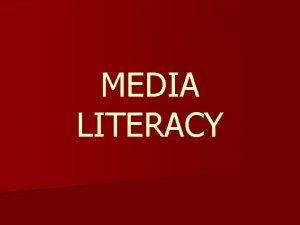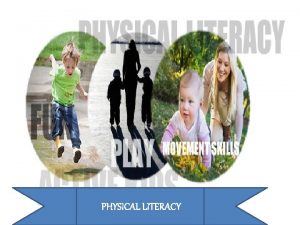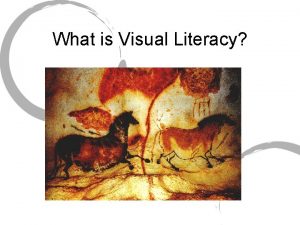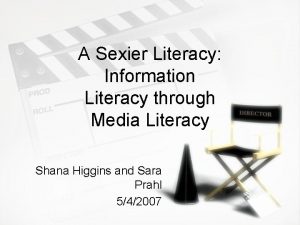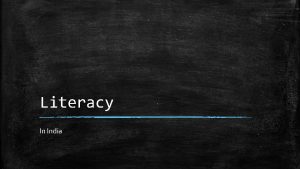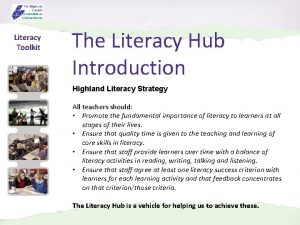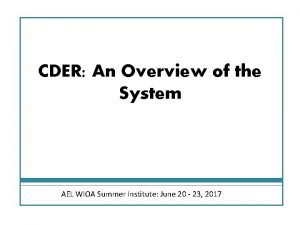Texas AEL Content Standards Literacy Texas 2017 Conference



























- Slides: 27

Texas AEL Content Standards Literacy Texas 2017 Conference August 1, 2017 Veramendi D

What’s your experience with Content Standards? a) Huh? b) I’m familiar, but I’m not really that much into it. c) I’m a believer. d) I probably know more than you.

What?

Education Standards In education, standards are a description of the skills and knowledge that students should have at a specified level. 3/8/2017 4

WIOA Regulation: § 676. 115 “…the Unified State Plan must describe how the eligible agency will, by July 1, 2016, align its content standards for adult education with Stateadopted challenging academic content standards under the Elementary and Secondary Education Act of 1965, as amended. ” TCCRS TEKS K 12 Standards STAAR 3/8/2017 Tx. CHSE Assessments GED®, Hi. Set, TASC College Standards TSI Assessment 5

Set at Exit-Level • Standards are set at exit or mastery level • Demonstrate mastery of content and skills • Offer educators and students a transparent view of what is expected at exit • Allow all stakeholders to gauge student preparedness for college, job training, entry and middle-skill employment 3/8/2017 6

Not Curriculum • Education standards are not a curriculum • They provide the road map for the targeted, systematic use of a curriculum • Schools, communities and educators choose their own curriculum, which is a detailed plan for day-to-day instruction • Clear standards provide educators with specific student performance indicators which drive instructional practice. 3/8/2017 7

Content Areas • English Language Arts & Literacy (pp. 13 -22) • Mathematics (pp. 23 -32) • English as a Second Language (pp. 33 -47)

Organization of Content Areas (pp. 10 -12) 9

Appendices • Educational Functioning Level Descriptors for Adult Basic Education, National Reporting System, 2016 (pp. 53 -80) • English Language Proficiency Standards for Adult Education and ELP Standard Level 1 -5 Descriptors (pp. 81 -92) New NRS Implementation guidelines to be released as soon as this month! 10

Why?

2005 -06 Lexile Framework® for Reading Study Summary of Text Lexile Measures p. 53 Text Lexile Measure (L) 1600 1400 1200 1000 800 600 High College Military Personal. Entry-Level SAT 1, College High School Literature. School Textbooks Use Occupations. ACT, Literature Textbooks AP* * Source of National Test Data: Meta. Metrics Interquartile Ranges Shown (25% - 75%)

History Year Action 2008 Texas Adult Education Content Standards and Benchmarks (TAECSB) 2009 Texas College and Career Readiness Standards (TCCRS) 2011 Gap analysis between TAECSB & TCCRS 2013 Federal CCRS 2014 WIOA passed 2016 Revised Texas AEL Content Standards 2017 Requirement in year 4 contracts 3/8/2017 13

ELAL - What is different from 2008? 2008 Focus on reading and writing for a variety of purposes 2016 Focus on reading and writing for an academic environment Includes Speaking New: Research section New: Computer skills New: Teamwork standard

Math - What is different from 2008? 2008 2016 Focus on numerical fluency and problem solving Focus on mathematical processes/practices and college and career readiness Benchmarks written on basis of progression levels Benchmarks written to align with K-12 standards and are much more rigorous

ESL - How Are These Different? 2008 2016 Focus on basic personal communication skills Focus on proficiency skills required for academic environments Less rigorous Emphasis on all 4 skillsspeaking, listening, reading and writing. More rigorous

How?

Unpacking the Standards To unpack standards means to do a close reading of the standard and, using evidence from it, be able to determine what students need to know and be able to do to meet the demands of that standard.

What’s in a Standard? what learners are expected to do to demonstrate mastery Skills situations where learners apply understanding of concepts and mastery of skills Context* Concepts information or ideas that learners are expected to know

Example: Skills, Concepts and Context Content Area: Math Subarea: II. 8 Financial Literacy Standard: Develop and use an economic way of thinking and problem solving useful in one’s life as a knowledgeable employee, consumer, provider, and investor. Benchmark: Calculate and compare simple interest and compound interest as it applies to saving, borrowing, and lines of credit. What do students need to be able to do (skills)? Calculate Compare In what context? Saving Borrowing Lines of credit What do students need to know (concepts or content)? Simple interest Compound interest Sample classroom activity:

Backward Design a good thing or a bad thing? Backward Design is a method of designing educational curriculum by setting goals before choosing instructional methods and forms of assessment.

What’s next?

Content Standards Rollout 23

Standards Alignment to Industry Clusters Awarded to Literacy Texas in June 2017 • Healthcare Science • Advanced Manufacturing • Construction and Extraction • Transportation, Distribution & Logistics

How this might work • O*Net, https: //www. onetonline. org/find/zone • Browse by Job Zone • Select Preparation Level • Select Occupation • Review knowledge and skills requirements • Cross check with Texas LMCI • Cross check with Texas Content Standards

Q&A 26

Contact Information John Stevenson Adult Education & Literacy Texas Workforce Commission John. Stevenson@twc. state. tx. us
 Ael-district
Ael-district ãel
ãel Remarca in aceasta secventa
Remarca in aceasta secventa Ael chimie
Ael chimie Similarities of media literacy and information literacy
Similarities of media literacy and information literacy Meme about media and information literacy
Meme about media and information literacy What is people as media and people in media similarities
What is people as media and people in media similarities Cyber literacy and digital literacy
Cyber literacy and digital literacy Content literacy continuum
Content literacy continuum Keys to content writing
Keys to content writing Arma conference 2017
Arma conference 2017 Cit international conference
Cit international conference Infor ion bi
Infor ion bi 2017 asco oncology practice conference
2017 asco oncology practice conference Njdv
Njdv Carrier content vs real content
Carrier content vs real content Static content vs dynamic content
Static content vs dynamic content Enterprise content management rfp
Enterprise content management rfp Hfap standards
Hfap standards 2017 english standards of learning curriculum framework
2017 english standards of learning curriculum framework Www.digitalliteracyassessment.org
Www.digitalliteracyassessment.org California content standards english
California content standards english California state standards english
California state standards english Colorado model content standards
Colorado model content standards Texas women in higher education
Texas women in higher education Biology staar
Biology staar Central texas conference umc
Central texas conference umc Texas assessment conference
Texas assessment conference
